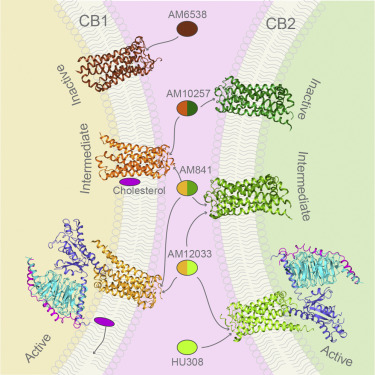Our official English website, www.x-mol.net, welcomes your
feedback! (Note: you will need to create a separate account there.)
Activation and Signaling Mechanism Revealed by Cannabinoid Receptor-Gi Complex Structures.
Cell ( IF 45.5 ) Pub Date : 2020-01-30 , DOI: 10.1016/j.cell.2020.01.008 Tian Hua 1 , Xiaoting Li 1 , Lijie Wu 1 , Christos Iliopoulos-Tsoutsouvas 2 , Yuxia Wang 1 , Meng Wu 3 , Ling Shen 3 , Christina A Brust 4 , Spyros P Nikas 2 , Feng Song 5 , Xiyong Song 6 , Shuguang Yuan 7 , Qianqian Sun 1 , Yiran Wu 1 , Shan Jiang 2 , Travis W Grim 4 , Othman Benchama 2 , Edward L Stahl 4 , Nikolai Zvonok 2 , Suwen Zhao 3 , Laura M Bohn 4 , Alexandros Makriyannis 8 , Zhi-Jie Liu 9
Cell ( IF 45.5 ) Pub Date : 2020-01-30 , DOI: 10.1016/j.cell.2020.01.008 Tian Hua 1 , Xiaoting Li 1 , Lijie Wu 1 , Christos Iliopoulos-Tsoutsouvas 2 , Yuxia Wang 1 , Meng Wu 3 , Ling Shen 3 , Christina A Brust 4 , Spyros P Nikas 2 , Feng Song 5 , Xiyong Song 6 , Shuguang Yuan 7 , Qianqian Sun 1 , Yiran Wu 1 , Shan Jiang 2 , Travis W Grim 4 , Othman Benchama 2 , Edward L Stahl 4 , Nikolai Zvonok 2 , Suwen Zhao 3 , Laura M Bohn 4 , Alexandros Makriyannis 8 , Zhi-Jie Liu 9
Affiliation

|
Human endocannabinoid systems modulate multiple physiological processes mainly through the activation of cannabinoid receptors CB1 and CB2. Their high sequence similarity, low agonist selectivity, and lack of activation and G protein-coupling knowledge have hindered the development of therapeutic applications. Importantly, missing structural information has significantly held back the development of promising CB2-selective agonist drugs for treating inflammatory and neuropathic pain without the psychoactivity of CB1. Here, we report the cryoelectron microscopy structures of synthetic cannabinoid-bound CB2 and CB1 in complex with Gi, as well as agonist-bound CB2 crystal structure. Of important scientific and therapeutic benefit, our results reveal a diverse activation and signaling mechanism, the structural basis of CB2-selective agonists design, and the unexpected interaction of cholesterol with CB1, suggestive of its endogenous allosteric modulating role.
中文翻译:

大麻受体-Gi复合结构揭示了激活和信号传导机制。
人体内大麻素系统主要通过激活大麻素受体CB1和CB2来调节多种生理过程。它们的高序列相似性,低激动剂选择性以及缺乏激活和G蛋白偶联知识阻碍了治疗应用的发展。重要的是,缺失的结构信息已大大阻碍了有前途的CB2选择性激动剂药物的开发,该药物可用于治疗无CB1的精神性炎症和神经性疼痛。在这里,我们报告与大麻素复合的合成大麻素结合的CB2和CB1的低温电子显微镜结构,以及激动剂结合的CB2晶体结构。我们的研究结果揭示了多种激活和信号传导机制,CB2选择性激动剂设计的结构基础,
更新日期:2020-01-31
中文翻译:

大麻受体-Gi复合结构揭示了激活和信号传导机制。
人体内大麻素系统主要通过激活大麻素受体CB1和CB2来调节多种生理过程。它们的高序列相似性,低激动剂选择性以及缺乏激活和G蛋白偶联知识阻碍了治疗应用的发展。重要的是,缺失的结构信息已大大阻碍了有前途的CB2选择性激动剂药物的开发,该药物可用于治疗无CB1的精神性炎症和神经性疼痛。在这里,我们报告与大麻素复合的合成大麻素结合的CB2和CB1的低温电子显微镜结构,以及激动剂结合的CB2晶体结构。我们的研究结果揭示了多种激活和信号传导机制,CB2选择性激动剂设计的结构基础,











































 京公网安备 11010802027423号
京公网安备 11010802027423号